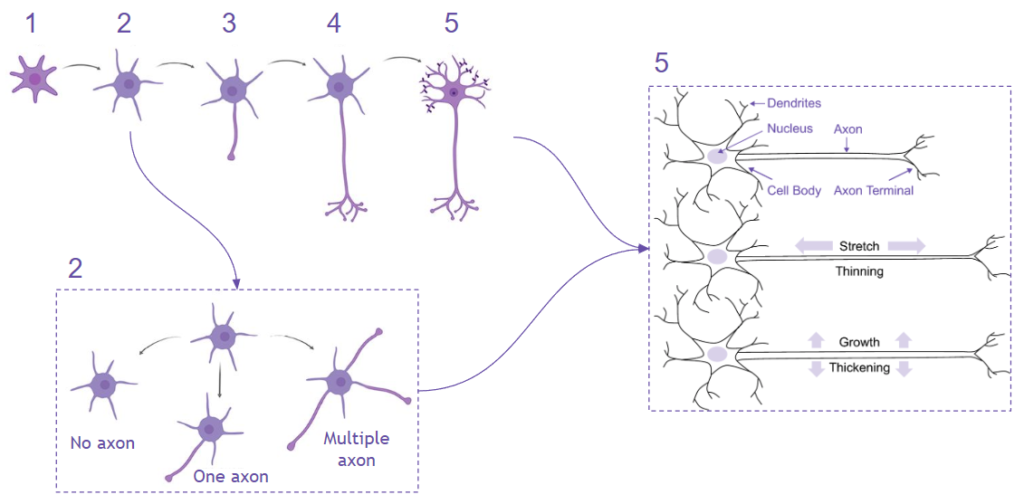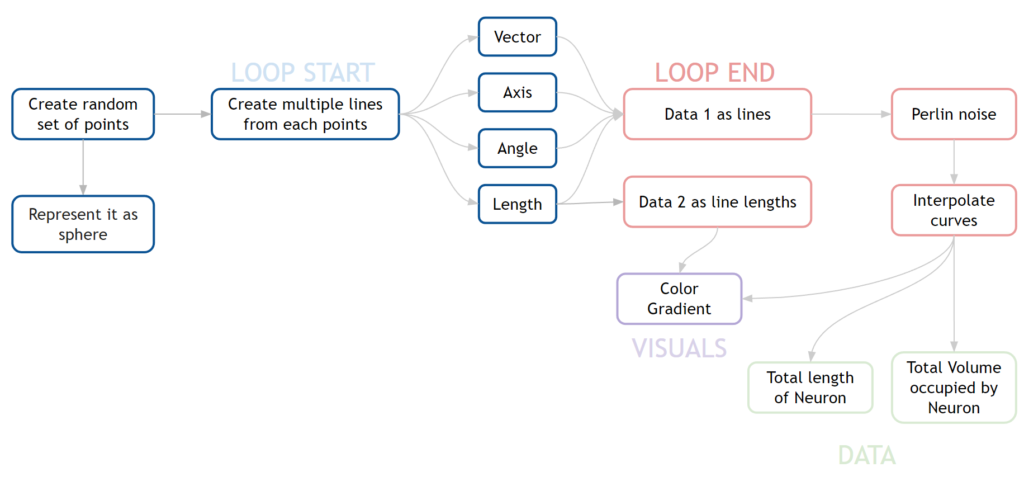- Neurons are the specialized cells that make up the nervous system. During their growth, neurons extend two types of processes: axons and dendrites, which navigate to other neurons and form complex neuronal networks that transmit electrical signals throughout the body.
- Neurons are organized into networks and circuits, where information is processed and transmitted. Neurons can form complex connections with many other neurons, creating intricate neural pathways.
- It is a dynamic process influenced by genetic, environmental, and lifestyle factors. It plays a critical role in brain function, particularly in learning, memory, and sensory perception.
Stages of Growth Process

Pseudo code
Generating Random Starting Points
- Random points are created in a 3D space to represent the starting points of neuron growth.
- These points are visualized as spheres to denote the location of the neurons.
Creating Random Dendrites
- For each neuron, dendrites (branches) are generated by drawing lines from the starting point.
- The length of each dendrite is determined by a multiplication factor, which can be adjusted based on the desired length of the dendrites.
- The direction of the dendrites is randomly rotated around the x-axis within a specified range of angles, providing randomness to the growth pattern.
Iterating for Multiple Axes
- The process of generating neurons and dendrites is integrated into a loop to generate growth in multiple axes.
- This allows for the creation of a complex neural network with branching structures extending in various directions.
Visualizing Neurons
- After the growth loops, the dendrites can be represented as curved lines to mimic the natural curvature of neural connections.
- The dendrites can be color-coded based on factors such as the length of the neurons or whether they represent old or newly grown neurons.
Calculating Total Length and Volume
- Once the neural network is fully generated, the total length of the neurons and the volume occupied by the network can be computed.
- This provides insights into the overall size and complexity of the generated neural network.

Parameters influencing growth
Growth rate
- Neurons need to grow at an appropriate rate to achieve functional integration within neural networks.
- Optimal growth rate ensures that neurons extend their processes to reach their target cells and form synapses with appropriate partners.
- This promotes efficient communication and information processing within the nervous system.
Branching angle
- The branching angle determines the spatial distribution of dendrites and axons, the branching structures of neurons.
- A well-balanced branching angle allows for optimal coverage of the surrounding area, maximizing the number of connections with other neurons. This ensures efficient communication within the neural network.
Influence of neighbouring element
- When two neurons come into contact with each other, a process called synaptogenesis occurs. During synaptogenesis, specialized structures called synapses form at the points of contact between the neurons.
- These synapses serve as junctions where information is transmitted from one neuron to another.
Single Neuron
Iteration 1
Iteration 2
Neuron System
Development of multi-neuron system and connectivity
Factors influencing growth
Multiplication – 3 I Length factor – 0.5 I Steps – 220 I Axis – X axis I Vector – 360
Factors influencing growth
Multiplication – 4 I Length factor – 0.5 I Steps – 290 I Axis – X axis I Vector – 180
Factors influencing growth
Multiplication – 3 I Length factor – 0.6 I Steps – 240 I Axis – X axis I Vector – 300
Challenges
Adjusting Connections Between Neurons
- Implementing algorithms to dynamically create, modify, and remove synaptic connections between neurons.
- Developing a strategy to ensure the stability and efficiency of the neuronal network as connections are adjusted over time.
- Addressing computational complexities associated with updating synaptic connectivity within large-scale neuronal networks.
Representing Continuous Growth and Death of Neurons
- Designing algorithms to simulate neuronal birth, growth, and death processes based on biological principles.
- Visualizing the dynamic turnover of neurons over time provides insights into the stability and plasticity of the neural network.
Communicating the Impact of Various Parameters on Neuronal Growth Rate
- Developing intuitive visualizations or interactive tools to illustrate the effects of different parameters on neuronal growth dynamics.
- Conducting sensitivity analyses to quantify the relative importance of individual parameters in shaping neuronal growth trajectories.
By addressing these challenges, the computational design project aimed to provide a comprehensive understanding of neuronal growth dynamics and their underlying regulatory mechanisms. Through innovative approaches and careful consideration of biological principles, the project sought to advance our knowledge of complex neural systems and their computational representations.

